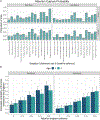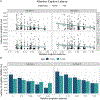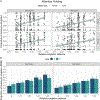A new perspective on the role of physical salience in visual search: Graded effect of salience on infants' attention
- PMID: 36355689
- PMCID: PMC9905344
- DOI: 10.1037/dev0001460
A new perspective on the role of physical salience in visual search: Graded effect of salience on infants' attention
Abstract
We tested 6- and 8-month-old White and non-White infants (N = 53 total, 28 girls) from Northern California in a visual search task to determine whether a unique item in an otherwise homogeneous display (a singleton) attracts attention because it is a unique singleton and "pops out" in a categorical manner, or whether attention instead varies in a graded manner on the basis of quantitative differences in physical salience. Infants viewed arrays of four or six items; one item was a singleton and the other items were identical distractors (e.g., a single cookie and three identical toy cars). At both ages, infants looked to the singletons first more often, were faster to look at singletons, and looked longer at singletons. However, when a computational model was used to quantify the relative salience of the singleton in each display-which varied widely among the different singleton-distractor combinations-we found a strong, graded effect of physical salience on attention and no evidence that singleton status per se influenced attention. In addition, consistent with other research on attention in infancy, the effect of salience was stronger for 6-month-old infants than for 8-month-old infants. Taken together, these results show that attention-getting and attention-holding in infancy vary continuously with quantitative variations in physical salience rather than depending in a categorical manner on whether an item is unique. (PsycInfo Database Record (c) 2023 APA, all rights reserved).
Figures







